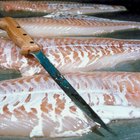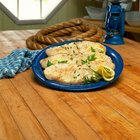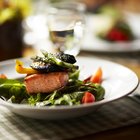
En papillote, the classic technique of wrapping and steaming food, gets a modern twist with aluminum foil. Foil conducts heat well and traps steam for fast, even cooking. Salmon cooks well using this method, because it's light and flaky. Be sure to add some moist ingredients, such as a savory sauce or vegetables, to produce steam. Even an ice cube will do.
Wrap It Up
To wrap salmon in foil, place a 12-inch square of foil on the counter top, dull side up. Lightly brush the foil with cooking oil. Place a salmon fillet on the foil and top with any desired vegetables, such as asparagus, broccoli or mushrooms. Parboil hard vegetables, including carrots or potatoes, before adding them to the foil packet. Top the food with seasonings, such as butter and herbs, teriyaki sauce or lemon. Bring the edges of the foil up around the food and fold the edges together twice. Fold the opposite ends together to make a neat packet. Punch a small hole in the top with a fork to vent the steam. Cook the packet on the grill or in an oven heated to 350 degrees Fahrenheit for 10 to 15 minutes, or until the salmon is firm and opaque.
Quick and Easy
The main advantage to cooking salmon in foil is its convenience. The neat little packets can be made a few hours ahead and stored in the refrigerator. In a snap, they go from fridge to oven or grill, and you can even serve the fish directly from the foil. Just cut the packet open, and eat. Cleanup is simple. Toss the foil in the trash and you're done. Another advantage to this method is that the foil traps steam to keep the salmon moist, tender and flavorful.
Get a Reaction
What you gain in convenience when cooking salmon in foil, you lose in cost and waste. Foil packets can't be used again and add to landfill waste. Using them also costs more than other methods of cooking salmon. Aluminum foil is reactive, meaning it reacts with acidic ingredients, such as tomatoes. In some cases, you may notice a slight metallic taste or discoloration of the food. The main disadvantage, though, is that you can't see the salmon, so gauging when it's done is difficult. Better to err on the side of caution and remove the fish from the heat early than overcook it. You can always put it back in the oven or on the grill if it's not quite done.
Try Something New
For moist, flavorful salmon without aluminum foil, you can poach the fish in a bit of broth, citrus juice or soy sauce in the oven or in a saute pan. Another approach is to use parchment paper, rather than aluminum foil, to make packets. This old method produces exceptionally moist results in a pretty package. The parchment paper is biodegradable and it won't react with acidic foods. Another plus to parchment paper is that it puffs and turns slightly brown when the food is done.
Related Articles

How to Smoke Food With Cedar Chips

How to Cook Foil Packs in the Oven
How to Cook Grouper in the Oven

Can You Cook Salmon in Foil Instead of ...

How to Boil Ziploc Bags

How to Make Baked Haddock in a Foil ...

How to Use a Probe Cooking Thermometer

How to Cook Salmon in a Steam Bag

How to Cook Thick Pork Chops in the ...

How to Cook a Teriyaki Steak in the Oven

How to Cook Salmon Fillets on the Stove ...

How to Cook Chicken in Parchment Paper

How to Freeze Catfish

How to Make a Foil Wrapped Potato

How to Grill a Cod Fish

Substitutes for a Tuna Steak

Lack of Nutrients and Flaky, Dry Skin

How to Broil Salmon in Foil

How to Cook Copper River Salmon
How to Cook a Halibut in Tinfoil in the ...
References
Writer Bio
Julie Christensen is a food writer, caterer, and mom-chef. She's the creator of MarmaladeMom.org, dedicated to family fun and delicious food, and released a book titled "More Than Pot Roast: Fast, Fresh Slow Cooker Recipes."
Photo Credits
Jupiterimages/Photos.com/Getty Images